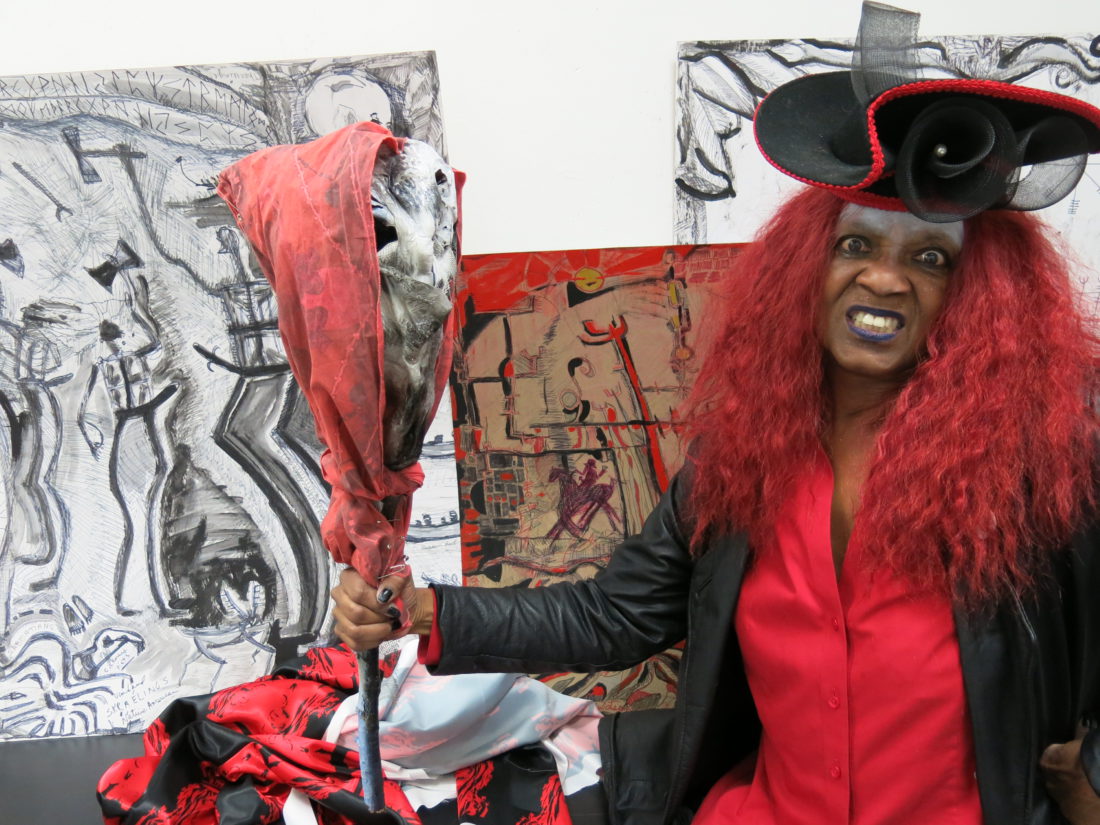“There are a lot of scared people in the world,” says mixed-media artist and priestess Valeria Watson. Fear, she observes, disconnects communities. It also makes for timid, uninspired conversation.
“Nobody asks questions,” Watson laments. “Nobody asks me, ‘Why is there white on your head?’” The reason, Watson explains, “is because I’m dealing with the white gods right now.” The decision to cover her forehead in white makeup, the artist continues, came as a directive from Odin, a prominent god in Norse mythology. In recent years, Watson says, she has been channeling the deity for guidance on her latest artistic endeavor.
On Friday, Dec. 6, Watson will debut her new installation, Völuspá Vision Story, at Pink Dog Gallery. Combining drawings, paintings, sculptures and textiles, the work offers a visual interpretation of “Völuspá,” the first known Norse poem.
Watson’s interest in North Germanic mythology began several years ago, following an extensive period studying her African lineage. (In 2008, Watson helped establish Osogbo as a sister city to Asheville; she is also the founder of the Zamani Refuge African Culture Center in Leicester.) “Once I had established who I was as a black person, I had the freedom to see who I was as a German person, or a Norse,” she says.
A descendant of both slaves and slave owners, Watson points out that her decision to trace her white ancestry is unusual. “Black people never talk about that,” she says. “We’re brought up to be ashamed of it.” As a child in the 1950s, Watson notes, obedience and silence ruled the day. White society, she explains, “tried to put us in a box. … We were taught, ‘Keep your head down.’”
A born rebel, Watson did not adhere to the social order based on white supremacy. Nor did she shy away from unusual company, including a stint in the 1970s with the New York City Chapter of the Hells Angels. Her then-husband was a member of the group, she explains, and brought Watson along to the Third Street clubhouse.
“I remember this one guy named Wild Bill,” she says. “Above his bed was this huge Nazi flag.” The symbol did not intimidate Watson. Instead, she saw it as a chance to engage.
“Some of them knew they were reincarnated Nazis,” she says of the chapter’s members. “And so we talked about, ‘Well, do you have to be stuck in your karma? Do you have to keep doing this over and over? Or can you forgive yourself … and sin no more?’”
Just as Adolf Hitler’s Nazi Party corrupted the swastika (previously used by several ancient societies as a symbol of well-being), today’s white supremacists have co-opted several of the Norse symbols, including Thor’s hammer and the Odal rune. Part of Watson’s upcoming exhibit features a collection of these stolen hieroglyphs. Their inclusion, Watson explains, allows her and fellow North Germanic descendants to reclaim and educate people about the original intent behind these designs.
Along with taking back bastardized symbols, Watson uses the ancient myths to study womanhood and the patriarchy. Her reinterpretation of “Völuspá” places its emphasis on the seeress’s history, rather than the poem’s focus on the world’s origin.
“To me, the seeress is a woman who is saying, ‘I remember a time when I didn’t have to hide my vagina. I remember a time when I could walk out naked and I wasn’t abused and I wasn’t harmed,’” says Watson.
Völuspá Vision Story, continues the artist, is an invitation to engage and sit with these difficult topics. The exhibit is also a chance to self-reflect and raise questions. Answers might not come easily, the artist cautions, but that shouldn’t prevent viewers from considering these complex matters.
“Everything is evolving and changing,” Watson says. “Hopefully, we keep changing, we keep learning. There’s always more depth. There’s always more things to explore.”
WHAT: Völuspá Vision Story
WHERE: Pink Dog Gallery, 348 Depot St. avl.mx/6qd
WHEN: Opening reception Friday, Dec. 6, 6-8 p.m. The exhibit will remain on view through Sunday, Jan. 5. Free






What is it with some modern artists and making everything about their genitals? Freud would have a field day! The Poetic Edda is easily readable in multiple translations online; there is no mention of vaginas anywhere in the Voluspa, not even metaphorically. Any ‘reinterpretation’ that ignores the entire narrative of the poem is nothing but a product of an artist’s own self-aggrandizing imagination.
you are correct. That is what we do. You are free to do as you please also. I love the Poetic Edda. Hope you see the installation. perhaps you will be happier.
Valeria, You are a true artist. I love artist who know and understand how to steal creatively. You have set the stage for the engaging conversation. Here’s to you, Friend.
CofE, ’69